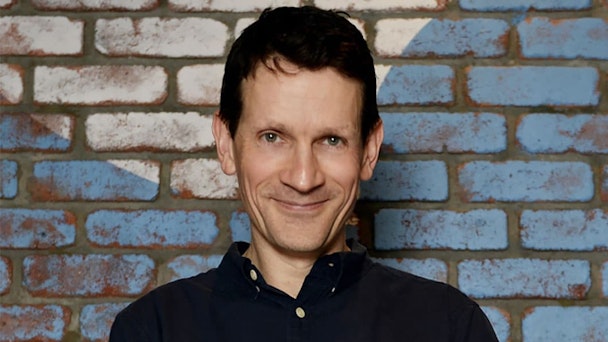Bruce Daisley on the office’s future: 'Whatever you do now, frame it as an experiment'
Bruce Daisley is a former vice-president of Twitter, creator of the Eat Sleep Work Repeat podcast and author of the book The Joy of Work. He sat down with members of The Drum Network to talk about building workplace culture in the new hybrid work environment and retaining talent amid the recent wave of resignations.

Bruce Daisley on the future of the office / via Bruce Daisley
An hour with Bruce Daisley, former vice-president at Twitter, is, ironically enough, a little like an hour scrolling through tweets: a whirlwind of quotations, figures, references, predictions and thoughts on topics ranging from the mayor of Paris to Comic-Con. That’s not to say it’s scattershot; in fact, all of this is focused quite keenly on two questions: what businesses are doing to build and maintain office culture in a world transformed by Covid-19 – and what they should be doing instead.
One common approach for businesses is, as always, to follow what the big players are doing. With Facebook and Google making significant real estate investments in Manhattan and elsewhere, it’s tempting to think that the smartest people in the industry are banking on a serious return to IRL working. Bruce, though, is “not convinced that those businesses have any insight into what’s coming next over anyone else” – they’re just cash-rich and investing in a traditionally stable commodity. Nor is he convinced that there is any one solution to the challenges of the moment that will be right for every business.
The five functions of the modern office
Instead of looking for a solution, the only reasonable approach to the office question, for Bruce, is to scrutinize why an office is valuable for you in the first place. Recalling a dictum coined by American academic Clayton Christensen (best known as the godfather of the idea of ‘disruptive innovation’ so popular in Silicon Valley), he says that “no one buys a drill to own a drill; they buy a drill to own a hole in the wall.” Similarly, no business should have an office simply to have an office; they should have an office (only) if doing so will help achieve desired results – in most cases, to have a productive workforce by “creating an energizing culture.”
Broadly speaking, he says, there are five ways in which an office can achieve that goal for you: in meetings by appointment; in meetings by accident; as a workshop; as a booster to team cohesion; and as a site for learning. The key to deciding a return-to-work policy is in understanding which of those elements are important to your business and what kind of working set-up is conducive to their flourishing.
Meetings by appointment, for example, matter far more in some businesses and roles than others; he recalls a discussion with TV commissioners who agreed that an in-person meeting is irreplaceably important before shaking hands on a deal. Meetings by accident, meanwhile, are a loss that few would have predicted but most have felt in the last couple of years: a Zoom call simply ends when we would, otherwise, have been having informal follow-ups at our desks, saying the things we were too cautious to say in the meeting.
As for team cohesion, “when we feel part of a congregation – a gang, a group – it generally lifts our wellbeing.” This shows physiologically as well as psychologically: endorphin levels rise; the heart beats a little quicker. It’s one explanation for the higher wellbeing metrics in people who regularly attend collective worship; and why recovery from mental and physical ailments alike is positively correlated with group membership. Crucially, as Bruce highlights, these kinds of benefits needn’t require meeting every day; indeed most worshippers are happy with once a week. All of which lends some credibility to increasingly popular approaches like ‘Wednesday plus one’ – the whole team in one day a week for cohesion, and another day of the worker’s choice for flexibility and accidental meetings.
The experimental approach
Bruce has no doubt that businesses thinking through these questions will have, as so many others have predicted, permanent consequences for working environments. “This moment has probably meant the death knell of big offices in city centers in the ways we know them,” he says. The role of the offices that do survive in the lives of the workers who use them will be changed too; “the office will increasingly say something about our organization,” becoming “an emblematic thing about our business” for those who can afford one. The result in many cases, he says (referencing work done in Leesman’s workplace index), will be that offices will be “half the size and twice the experience.”
Answering why your business needs its workers back has a dual benefit. With workers mostly wanting to remain at home for at least part of the week and more aware than ever of what they’re missing out on at home when they’re at the office (or traveling to it), being able to answer the question, ‘why do I need to come in?’ will be essential. It should also help you to avoid the pitfalls that Bruce has occasionally seen in his consulting work, with businesses encouraging early returns to empty offices. “If people found that the office was empty, they never did it again.”
Experiences like that inform Bruce’s final kernel of advice: “Whatever you do now, frame it as an experiment.” Businesses are, quite naturally, concerned by increases in resignations, staff shortages and other sources of uncertainty; the impulse to exert control is, for Bruce, understandable. But a control approach will only push workers further away, obliterating the feeling of increased control and flexibility they’ve come to enjoy. An experimental approach allows you to lead with a question rather than an order: “Will this be a disaster?”
Bruce spoke to us as part of the Better Business series, hosted by head of The Drum Network Holly Hall. Next month, she’ll be speaking to Nicki Unsworth, former chief executive officer at JBL.

